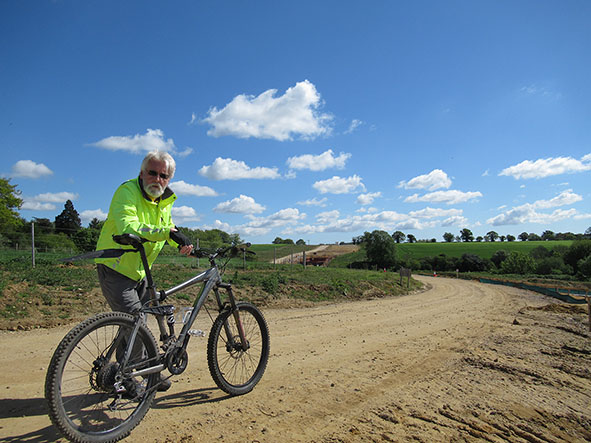- Screen Colours:
- Normal
- Black & Yellow
Scottish Power Renewables are installing 100 wind turbines in the North Sea, clustered in a wind farm: East Anglia One. Situated 40 kilometres off the Heritage Coast the power will come ashore at Bawdsey. For connection to the National Grid and onward distribution to our homes and businesses they have installed a multiple array of underground cables which stretch between the coast at Bawdsey and Bramford, encircling north and west Ipswich en route.
The 37 km trench was dug and the cable installed by Murphy, a civic engineering contractor whose first job on the site was to construct a haul road, a hardcore track alongside the cable trench on which they could run their site vehicles without clogging up local roads and upsetting the neighbours.
Since I first learnt of this temporary piece of expensive infrastructure I thought it would make, once the work is finished, a good ‘off-road’ cycle route. What a waste it would be if they were to dig out all of that carefully compacted road-stone only to bury it elsewhere as landfill?
The cable route crosses the Bawdsey peninsula and immediately dives under the River Deben to Falkenham. From there, the haul road is all but continuous to Claydon where the cables have been pushed under the A14 and under the River Gipping and into Bramford. The distribution station is on top of the hill where the pylons converge.

My suggestion for a cycle route has caused some interest in both Suffolk County Council and at Sustrans but no action has been taken. So, when the sun came out in mid-March, I decided to cycle the route to confirm for myself what a wonderful asset was sitting on our doorsteps.
I cycled out of Ipswich towards Claydon, along the old Norwich Road (buses and cycles only); to the construction site that marks the end of the visible trench. It was here that Murphy’s sited their horizontal drilling machine to push the cable underground and unseen through to Paper Mill Lane. My destination, unlike the cable was not Bramford but east to Akenham, Witnesham and eventually Felixstowe. Because of all their expensive drilling equipment the site was secure so I cycled along the bridle path to Rise Hall and the isolated St Mary’s Church at Akenham.
I was immediately struck with the wonderful situation that this potential route offered; just half a mile from the urban sprawl of Whitton and I was deep into the Suffolk countryside. I cycled across Henley Road and on towards Witnesham.
Following the cable trench as it avoids the Fynn Valley Golf Course, it struck me just how many people were out enjoying the tranquillity of the Suffolk countryside. Being a sunny Sunday morning, there were golfers, plenty of those BMX cyclists in a coppice at Claydon, a scattering of horse-riders on the bridle paths, model aeroplane enthusiasts in a farmer’s field close to Cockfield Hall and scores of walkers enjoying their Sunday morning stroll.
Below: Chairman of Ipswich Society in trail bike power cable mercy dash shock.

There were twenty or so fishermen dipping their hooks into a small lake close to Akenham and a guy with his dog and ferret on the edge of a wood. Most surprising of all were the donkeys – two alongside Waldringfield Road and another two pulling a donkey cart along Wash Lane, Witnesham. I was simply amazed at the variety of activity taking place on the peripherals of Ipswich, a town that continues to surprise.
Into the Fynn Valley at Bealings and across the A12 at Seckford, I skirted Martlesham Creek and up the hill towards Waldringfield. From here the route is undulating, through Hemley and Kirton Marshes until I reached the river wall at Falkenham where the cable disappears under the Deben to resurface at Bawdsey.
I simply cycled down to the ferry and then turned right into Felixstowe. This route has the potential to be a substantial asset for Ipswich and for Suffolk: a cycle route that could rival the Marriot Way in Norfolk or the Crab and Winkle out of Canterbury.
John Norman